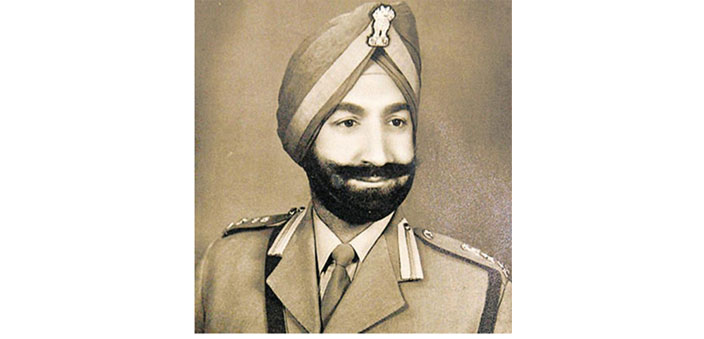A tactical and brave officer (1921-2015)
Brig. Sant Singh was born on 12 July 1921 in Faridkot. His father Sardar Arjan Singh was a farmer and Sant Singh studied in the village school. He served as a soldier for three years in the Corps of Engineers, and participated in the Second World War. He was commissioned into 1st Battalion of the 14 Punjab Regiment on 16 February 1947 in the NWFP, and took part in the liberation of Junagadh, in the 1947-48 war in Kashmir, and the Indo-China War of 1962. He was later transferred to 5 Sikh Light Infantry (L I) Battalion, and took over as the commanding officer in 1964.
Pakistan had occupied OP Hill Complex in Mender sector in Rajouri area despite the ceasefire in 1965. The feature dominated the Meder-Balnoi road and isolated the administrative base of the battalion at Balnoi. The terrain was difficult. Anticipating an attack, the enemy had laid mines on the approaches to the objective, and had arranged heavy artillery fire. Attempts by the unit located there failed, and 5 Sikh L I was moved to Mender sector to clear this feature. It was a new battalion and the officers were young. There was only one company commander who had more than three years of service. Sant Singh personally led the attack before midnight on 2 November. He had selected an unexpected direction for launch of the attack, and it was an outright success. The morale of the troops was high and Sant Singh decided to exploit the success by clearing three more objectives which were to be cleared by another battalion. By midnight, the highest feature was captured. The hills reverberated with the sounds of “Reveille on the bugle”.
He did not wait for any directions from the brigade commander and completed the capture of the entire hill inspite of severe opposition by the enemy, who had concentrated effective artillery fire. Each bunker had to be cleared by hand to hand fighting. Lt. Col.(later Brigadier) Sant Singh had made maximum use of local resources and was awarded the MVC. The battle honour “Chuh-i-Nar 1965” was bestowed on the regiment.
In 1971, he was commander of a sector in East Pakistan, and was part of the force under Major General Niagra. After liberation of Jamalpur, Sant Singh occupied Mymensingh on his own, and sent 6 Bihar to pursue the retreating enemy troops. The unit occupied Madhupur by 0800 hours on 12 December. The success of operations so far had acted as a spur for the advance to Dacca, and General Niagra called Sant Singh forward.
He was given the task to advance along Chandpur-Sabhar-Mirpur axis, and establish a road block at Nayarhat to intercept the retreating Pakistani soldiers. An additional battalion, 13 Guards, was allotted to him for the task. He achieved spectacular results with a mixed force of Mukti Bahini and one regular battalion. He advanced about 60 km to Madhupur in eight days. He had no engineer support and the enemy had blown off all the bridges. The advance was, therefore, mostly on foot. After establishing the road block at Nayarhat, 13 Guards contacted Sabhat in the early hours of 15 December. The Pakistani troops withdrew for fear of being outflanked, and Sant Singh secured the town by evening of 15 December.
A ceasefire was announced on 15 December and General Niagra accompanied by Sant Singh and Brig Kler moved to join 2 Para, the unit which had carried out an airborne operation. General Niagra sent his ADC to General Niazi to give up. For his inspiring leadership and courage, he was awarded the MVC a second time, and was one of the six officers to have received this gallantry award twice. He retired in 1973 and was president of the unique organisation – War Decorated India.
He passed away on 8 December 2015. A large number of officers led by former COAS General Malik and serving officers from the Western Command paid their respects to the outstanding warrior. A contingent from 5 Sikh LI, the unit that he had commanded, came to present honours to their former commanding officer.

